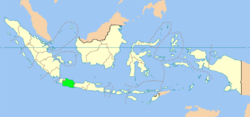West Java Province
|
West Java Jawa Barat ᮏᮝ ᮊᮥᮜᮧᮔ᮪ |
||||||||
|---|---|---|---|---|---|---|---|---|
| Province | ||||||||
Clockwise, from top left : Kawah Putih, Scenery of Garut, Mount Ciremai, Jatiluhur Dam, Bandung Skyline, Pangandaran Beach
|
||||||||
|
||||||||
| Motto: ᮌᮨᮙᮂ ᮛᮤᮕᮂ ᮛᮨᮕᮨᮂ ᮛᮕᮤᮂ Gemah Ripah Repeh Rapih (Sundanese) (meaning: Serene, Prosperous, Peaceful, United) |
||||||||
 Location of West Java in Indonesia |
||||||||
| Coordinates: 6°45′S 107°30′E / 6.750°S 107.500°ECoordinates: 6°45′S 107°30′E / 6.750°S 107.500°E | ||||||||
| Country |
|
|||||||
| Established | August 19, 1945 | |||||||
| Re-established | July 14, 1950 | |||||||
| Capital |
|
|||||||
| Government | ||||||||
| • Body | West Java Regional Government | |||||||
| • Governor | Ahmad Heryawan (PKS) | |||||||
| • Vice-governor | Deddy Mizwar | |||||||
| Area | ||||||||
| • Total | 37,173.97 km2 (14,352.95 sq mi) | |||||||
| Area rank | 21st | |||||||
| Highest elevation | 3,078 m (10,098 ft) | |||||||
| Lowest elevation | 0 m (0 ft) | |||||||
| Population (2015) | ||||||||
| • Total | 46,709,600 | |||||||
| • Estimate (2016) | 47,379,389 | |||||||
| • Rank | 1st | |||||||
| • Density | 1,300/km2 (3,300/sq mi) | |||||||
| • Density rank | 2nd | |||||||
| Demonym(s) | West Javan Warga Jabar (id) Urang Jabar (su) |
|||||||
| Demographics | ||||||||
| • Ethnic groups | Sundanese (79%), Javanese (10%), Cirebonese (7%), Betawi (4%) | |||||||
| • Religion | Islam (97%), Christian (1.81%), Buddhist (0.58%), Confucianism (0.22%), Hinduism (0.05%), Sunda Wiwitan | |||||||
| • Languages |
Indonesian (official) Sundanese (regional) Cirebonese (minority) Betawi (minority) |
|||||||
| Time zone | Indonesia Western Time (UTC+7) | |||||||
| Postcodes | 1xxxx, 4xxxx | |||||||
| Area codes | (62)2x, (62)2xx | |||||||
| ISO 3166 code | ID-JB | |||||||
| Vehicle sign | D, E, F, T, Z | |||||||
| GRP nominal | US$ 144,370,800,000 | |||||||
| GRP per capita | US$ 3,136 | |||||||
| GRP rank | 22nd | |||||||
| HDI |
|
|||||||
| HDI rank | 11th (2016) | |||||||
| Largest city by area | Bekasi - 206.61 square kilometres (79.77 sq mi) | |||||||
| Largest city by population | Bandung - (2,575,478 - 2014) | |||||||
| Largest regency by area | Sukabumi Regency - 4,145.7 square kilometres (1,600.7 sq mi) | |||||||
| Largest regency by population | Bogor Regency - (5,331,149 - 2014) | |||||||
| Website | Regional Government site | |||||||
West Java (Indonesian: Jawa Barat, abbreviated as "Jabar", Sundanese: ᮏᮝ ᮊᮥᮜᮧᮔ᮪ Jawa Kulon) is a province of Indonesia. It is located in the western part of the island of Java and its capital and largest urban center is Bandung, although much of its population in the northwest corner of the province live in areas suburban to the even larger urban area of Jakarta, even though that city itself lies outside the administrative province. The province's population is 46.3 million (in 2014) and it is the most populous of Indonesia's provinces.
The central areas of Bogor, a city in West Java, has one of the highest population density worldwide, while Bekasi and Depok are respectively the 7th and 10th most populated suburbs in the world (Tangerang in adjacent Banten province is the 9th); in 2014 Bekasi had 2,510,951 and Depok 1,869,681 inhabitants. All these cities are suburban to Jakarta.
The oldest human inhabitant archaeological findings in the region were unearthed in Anyer (the western coast of Java) with evidence of bronze and iron metallurgical culture dating to the first millennium AD. The prehistoric Buni culture (near present-day Bekasi) clay pottery were later developed with evidence found in Anyer to Cirebon. Artefacts (dated from 400 BC — AD 100), such as food and drink containers, were found mostly as burial gifts. There is also archaeological evidence in Batujaya Archaeological Site dating from the 2nd century and, according to Dr Tony Djubiantono, the head of Bandung Archaeology Agency, Jiwa Temple in Batujaya, Karawang, West Java was also built around this time.
...
Wikipedia







